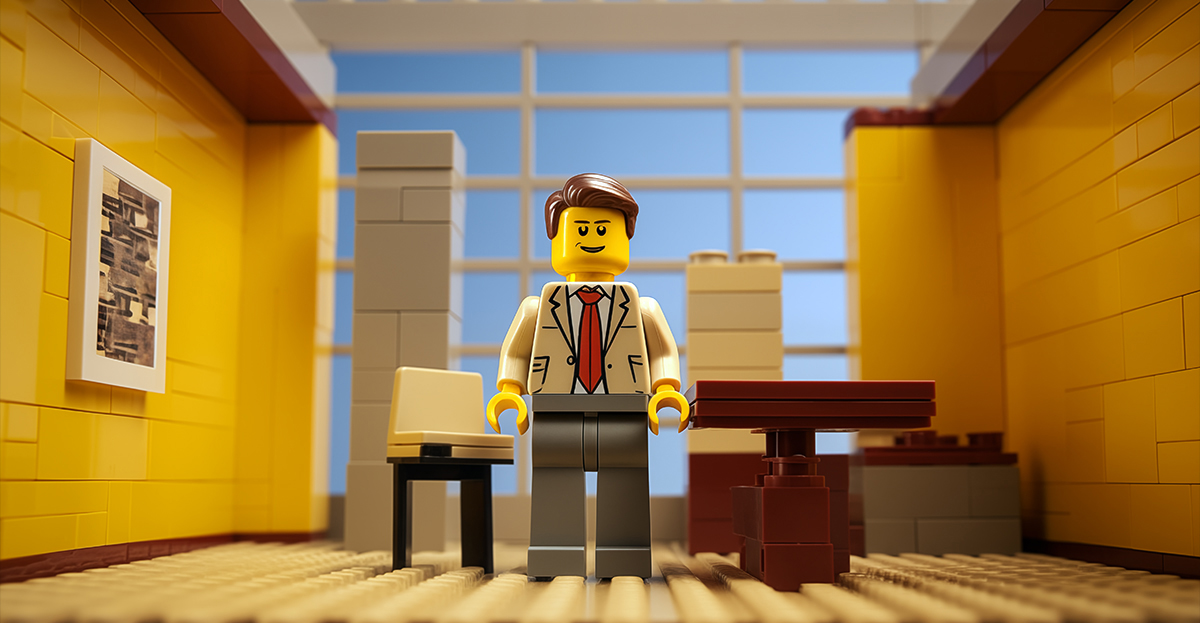From a design standpoint, some things are just cooler than other things – and these things don’t need to be justified to anyone because people either understand it or they don’t … but that doesn’t mean there isn’t an interesting and amazing story behind these objects that might contribute to their coolness in a meaningful way. Today Andrew and I each selected three items and we are going to share with you some amazing stories … Welcome to EP 144: Objects of Design
[Note: If you are reading this via email, click here to access the on-site audio player]
Podcast: Embed
Subscribe: Apple Podcasts | Spotify | Android | iHeartRadio | TuneIn
Today we are going to share with you something we feel is meaningful to us and why, maybe, it should be meaningful to you. Rather than making this a list of things we like – and by extension – things we think you should like as well, we are going to dig a bit deeper and talk about the story behind each item we discuss today. In a sense, it’s that story that should make today’s podcast interesting … just that fact that WE think it’s interesting probably isn’t good enough, so we are stepping up our game.
The rules are simple – Andrew and I were each tasked with identifying a handful of items that we think are worthy of being labeled “Objects of Design” and we are going to present them in an alternating fashion. We are going to be keeping score because, at the end, I want my list to be better than Andrew’s list.
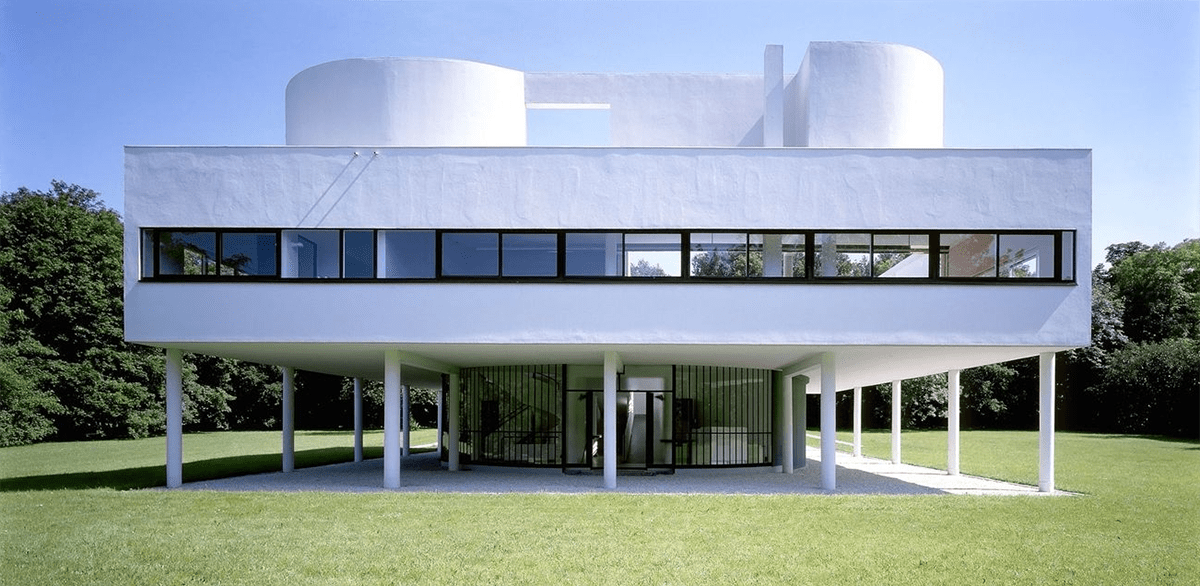
Villa Savoye jump to
I am starting my list today with a building – one that architects, fans of architecture, and French people should all be familiar with … Villa Savoye, a modernist villa designed by Charles-Edouart Jeanneret-Gris, better known as “Le Corbusier” and his cousin Pierre Jeanneret located just outside Paris, France in the town of Poissey. It was built out of reinforced concrete between 1928 and 1931. The villa was designed for Pierre and Eugenie Savoye as a country home but the reality is that they barely lived there, but I’ll get to that in a moment.
I visited this building in the Fall of 1990 after having become quite familiar with the work as a result architectural history classes and quite honestly, even though it was not the popular still of architecture at the time, I really enjoyed Le Corbusier’s work, not so much some of his ideas on Urban planning.
But to really get to the interesting part of this particular project, we have to go back to 1927 when the League of Nations rejected the modern building that Le Corbusier and his cousin Pierre Jeanneret proposed for its headquarters. To say Le Corbusier was disappointed would be an understatement and this moment became a jumping off point that led to Le Corbusier forming the International Congresses of Modern Architecture in 1928. Another Swiss from Zurich, Siegfried Giedion, who was trained as an Engineer, attended the Bauhaus School where he met Walter Gropius and formed his initial interest and opinions on the modern architecture movement, was the Secretary of the International Congress of Modern Architecture and he, along with Le Corbusier wrote the Working Programme of the congress and formulated the text of the declaration. This program would eventually be distilled into the 5 principals of architecture that I will mention in a
Just from that standpoint, Gideon plays an important role into what Villa Savoye is at its essence but he actually continued to play a role in the building as well as its salvage from destruction.
So it’s now September 1928 and Le Corbusier has taken on the commission of Villa Savoye. It is called that, maybe obviously because it was the summer house for Pierre and Eugénie Savoye.
The Savoye’s developed a brief that called for the programming of the villa, but according to apparently Le Corbusier was given free reign aesthetically and he used this project to articulate some ideas that he had been working on and what would eventually be articulated in the book “Vers une Architecture” – which translates to Toward a New Architecture. The principals as all architecture students learn are:
- Pilotis (or pillars)
- Roof Garden
- Open Floor plan
- Long windows
- Open Facades
And all of these principals are on display the Villa Savoye.
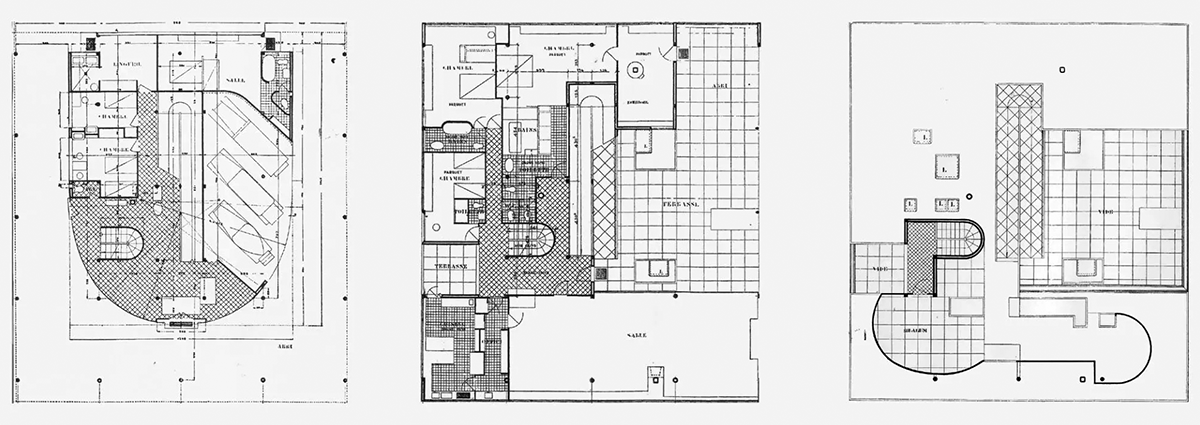
Construction started in 1929 and was virtually completed within a year but the house wasn’t habitable until 1931. Meanwhile Gideon has been writing and starting publishing articles about Villa Savoye and how it was an exemplary building of new architecture – which of course he would think this as it reflected the principals of architecture he and Le Corbusier set out in the International Congress of Modern Architecture. These initial articles were bring a lot of attention to the Villa but it was still under construction during this period and hadn’t been lived in yet.
There are a handful of historical documents you can find on the internet that show a dialog between Giedion and a publisher by the name of Christian Zervos, some are focused around the photography being used in these articles – most of which was either taken by Pierre Jeanneret or Giedion and how they weren’t all that great – but the images I’ve seen look pretty amazing as the Villa is unfinished and it is about as diagrammatic a building as you might ever see.
Moving forward a bit, the Savoy’s lived in the house until WWII, at which point it was commandeered by the Germans who apparently used the Villa to store hay. Not too long after, it was passed along to the Americans who used it for purposes other than storing hay. When it returned to the Savoye’s they were no longer in a position to live as they had done before the war and the house was abandoned. The city expropriated the Savoye property in order to build school buildings – meanwhile Le Corbusier was not aware of all of this and was notified by the family in 1959 what was going on and he took immediate action in an attempt to save the Villa.
Le Corbusier talked with the city and essentially learned that the only steps that could be taken to save the villa was to buy it outright. Corbusier reached back out to Giedion was in New York at this time, was that this was not a vanity exercise but that the Circle of Architectural Studies of Paris, Andre Malraux – who was the minister for Cultural Affairs and UNESCO had all been briefed on the matter but none came forth with the money to purchase the property. What these folks could do is identify the property as being of historic value and they could simply appropriate it – but there was not even the slightest intention to do this. So Le Corbusier reached out to Giedion and basically asked him secure American money to make this purchase. If you read enough on this you can see that there is an exchange where Gideon tells Corbusier to let him know exactly how much Poissey paid for the expropriation, Corbusier’s estimate for the cost of the renovation, and for what purpose would the Villa essentially exist once it was secured and repaired?
“From the American point of view it is impossible to ask for money without knowing the exact sum and the use to which it will be put?” ~Siegfried Giedion
Based on the estimates of agronomists as to the estate and its fruit trees, along with Le Corbusier, they determined it would be 100 million Francs.
Since this was an extreme amount of money, What Le Corbusier did in an attempt to save the Villa Savoye is rather remarkable. He set up a “Le Corbusier Foundation” where the foundation would be Corbusier’s sole heir. He states that there is an asset of very significant value: thousands of drawings, some 200 paintings, the whole of architectural and Urban planning designs from 1922 onward, the royalties on about 50 books, etc. “All of this money is in front of us, it is never in my pocket because my pockets never had it.”
I found this 4K video walkthrough of the project which can help you to not only see the building, but you’ll be able to see how the spaces work with one-another.

Barcelona Pavilion Chair jump to
So my first selection is the Barcelona chair. This iconic piece has always been attributed to Mies van der Rohe and debuted at the 1929 International Exposition in Barcelona, Spain. Initially conceived for the German Pavilion (i.e. the Barcelona Pavilion) there were only two chairs in the original pavilion. Of course we know the chair is now very popular and an icon of Modernism and Modernist design. But recently it has come to light that Mies worked very closely with Lilly Reich on the creation of the chair. Reich, an influential figure in early Modern Movement design, worked closely with Mies van der Rohe during the Weimar period, crafting textiles, furniture, and exhibition spaces. She was a master member of the Bauhaus; in fact the first female master craftsman. Their collaboration was significant and extended to projects like the Stuttgart “Die Wohnung” exhibition and the Barcelona Pavilion, where the iconic chair debuted.
Lilly Reich’s vision emphasized industry integration and mass production. This was clear in her design approach during the 1929 International Exposition. She advocated for the seamless integration of mass-produced items, showcasing them in refined contexts. This philosophy was shared by Mies and others at the time. In many parts of my research referenced Mies and Lilly as “inseparable companions” during the short period of the Bauhaus and up until Mies moved to the United States in 1938. Their partnership extended beyond design projects, encompassing teaching roles at the Bauhaus and numerous exhibition curation ventures. Notably, their joint efforts birthed iconic pieces like the Barcelona Chair and Brno Chair, leaving a lasting imprint on modern furniture design.
Despite their shared accomplishments, Reich’s contributions often went overlooked, a result of the typical behaviors of the time, as she is rarely recognized in historical texts. However, her influence persisted, shaping not only furniture design but also exhibition practices and teaching methodologies. I think one of the most curious conditions of their relationship that speaks to her role in the creation of this chair and others accredited to Mies is that Mies only created furniture during their time together. He did not design or license any other piece of furniture for the rest of his career. Read into that what you will, but I think it speaks volumes.
So back to the chair… the evolution of the Barcelona chair’s construction was one that mirrored advancements in metal fabrication to some degree. The original chair was a bolted chromate-plated steel S-form that supported the chair. While I could not find any images, there are several references to this design conditions. If I had to guess, it may have been bolted and ground very smooth prior to being plated. Then in in 1950, due to advancements in metal crafting, the base began being crafted from a single piece of seamless stainless steel frames. Similarly, the shift from the original ivory-colored pigskin to bovine leather facilitated made production more efficient and economical. Today it comes in multiple colors and qualities of leather.
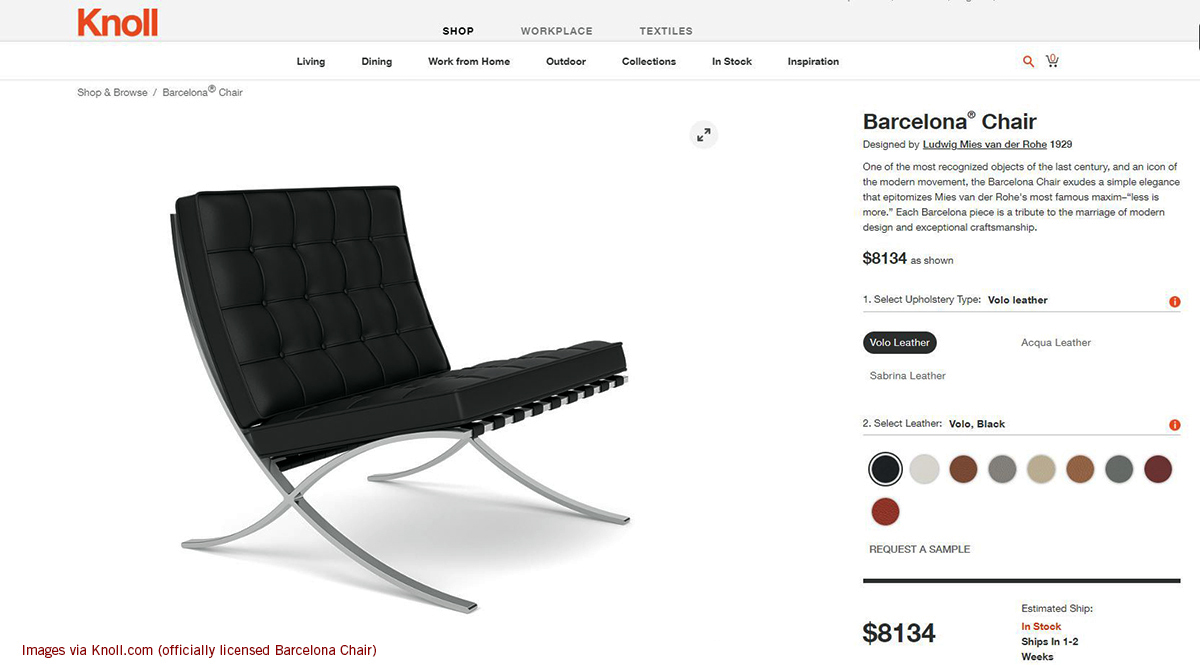
The Barcelona chair’s design origins came from the Roman Curule seat. This was a folding type chair used by roman aristocracy as seating when traveling. A similar type of X-shaped base was used in those collapsible chairs. These chairs were utilized in many parts of Europe later in history even a late as Napoleon. A similar chair with an X-base can also be traced all the way back to the Egyptians. Of course the Barcelona chair has turned the X into more of an S shape used for the stainless steel base. The chair was designed to be used by the King and Queen of Spain for seating at the pavilion during the Exposition. So the subtle design nod to nobility of the past is quite ingenious.
From its introduction in 1929 through the late 1940’s the chair was not overly produced. Some this this can be attributed to the difficulty of original manufacturing process, the closure of the Bauhaus by the Nazis (1933), and then also the period of World War II. After Mies came over to the US, in the early 1940’s, he became friends with Florence Knoll. So as his ownership of the license for the chair was nearing its expiration, Mies signed it over to the Knoll Company in late 1940’s. Since 1953, Knoll has been the officially licensed manufacturer of the Barcelona Chair. As of the date of this post, a new licensed Barcelona Chair from Knoll will cost you $8,134. (As a note, this price is double of 2018.) Of course, there are a plethora of knock-off reproductions on the market. They can range from a few hundred dollars to nearly three-thousand dollars. While the reproductions may not be “official”, there are several that are of near similar quality. Many of these pride themselves on using the same specifications as the original chair. For the past decade or so, Knoll has been in several lawsuits over the rights to the Barcelona Chair. While water is still murky on the true ownership of the license, Knoll seems to be pursuing most knock-off manufacturers.
So in summary, this is a quintessential example of modern furniture. As we have learned, while attributed to Mies van der Rohe it was most likely designed by Lilly Reich. And even with all its licensing turmoil, the chair is clearly still a symbol of modernist design as it has been in almost continuous production since 1929. Now I just need to buy one or two. Or if anyone has one they want to donate, I am all in favor.

The Swiss Army Knife jump to
For my 2nd object of design, I pivoted a bit and decided to look up the story behind the Swiss Army knife. Not to make this age specific but I feel like people in the neighborhood of my age group grew up either being a Swiss Army knife person or they didn’t – and that decision wasn’t accidental. I had two, and I’m pretty sure I stole both of them from my parents. My Dad had what I believed to be the most traditional knife – which was the one known as “The Huntsman” but I secretly coveted ones that my friends had that included a toothpick and tweezers. The one I took from my mom was incredibly tiny and barely had any blades to it at all – I looked it up and it’s called the “Classic SD Classic” and it has a knife and nail file on one side, a pair of scissors on the other, and the coveted toothpick – which actually seems kind of gross to me now.
During the 1880’s, the Swiss Army decided to purchase a new folding pocket knife for their soldiers so that they would be able to maintain their service rifles, which required a screwdriver, and a can opener. At that time, there wasn’t a Swiss company with the capacity to fill the initial order for 15,000 knives so a German company by the name of Wester & Company was retained. This initial order was filled and delivered towards the end of 1891. This initial model was designated Modell 1890 – supposedly for the year the order was placed even though it makes more sense to me that it should have been called Modell 1891. This first knife met the original requirements and included a blade, reamer, can opener, and a screwdriver.
At this point, Karl Elsener entered the picture. Karl Elsener was Swiss inventor and a cutler and he owned a company that made surgical equipment – so this all kind of makes sense. He was now competing directly with the German run Wester & Company to make the Modell 1890 and for about 5 years, he was losing a lot of money as he couldn’t make these knives at a competitive cost and he was on the verge of bankruptcy. He had a breakthrough in 1896 when he came up with the idea for an improved knife that had all the tools spread across both sides of the knife. This was a fancier knife and was intended for use by officers. He filed a patent on this new knife and called it the Schweizer Offiziers und Sportmesser – which means Swiss Officer’s and Sports knife. Ironically, the Swiss military did not commission the knife. That did not take place for another 12 years in 1908.

Elsener ended up renaming his company to Victorinox as his mother Victoria in her honor after she passed. There was some competition for what we all know now as the Swiss Army knife as the Elsener knife was quite popular and the Wenger Company split the Swiss Army contract with Victorinox and they agreed that Wenger would advertise his knife as “the genuine Swiss Army Knife” and Elsener would use “the Original Swiss Army knife”. Almost 100 years later, in 2005, Victorinox bought Wenger and once again became the sole manufacturer and supplier of Swiss Army knives.
The reason is it called a Swiss Army knife and not “Modell 1890” is because Swiss Army Knife was a term coined by US soldiers after WWII because they had a hard time pronouncing the German word “Offiziermesser” meaning “officer’s knife”. In addition, the Swiss Army knife isn’t actually the first multi-use pocket knife. According to Wikipedia, Herman Melville mentions one in Chapter 107 of Moby Dick.
Last fun fact: Victorianox makes 50,000 knives each year for the Swiss Army, they make an average of 45,000 knives each day, and over 9,950,000 knives are sold via retail markets each year.
Legos jump to
This story starts in a small village in Denmark named Billund. A young man by the name of Ole Kirk Kristiansen after having completed his mandatory military service and with is carpentry journeyman certificate in hand, busy a woodshop in Billund. At the time, Ole Kirk is 24 years old. He came from a large family of 12 siblings and grew up modestly about 20 miles outside of his now home Billund. Within the confines of his new establishment, Kristiansen’s work encompassed the creation of utilitarian furniture like ladders, stools, and ironing boards, which he wanted to produce with the utmost quality and craftsmanship.
For several years business was modest, but good. However, things took a turn in 1924 when an accidental fire, ignited by two of Ole Kirk’s sons, burnt his workshop and familial abode to ashes. Undaunted by the calamity, Christiansen perceived opportunity amid adversity, resolutely committing to the reconstruction of an expanded and larger workshop facility after the fires. Also his new home was a much larger residence.
Again, Ole Kirk grew the business and was making progress when the Great Depression fell upon the world in the late 1920’s. Then in 1932, his wife died leaving him the sole caretaker of their four sons. In the face of mounting tribulations, he had to let many of the woodshops employees go and business began to fail. During the Depression, Denmark had a subsidization program that Ole Kirk utilized to keep things afloat. Embracing a strategic pivot, Christiansen redirected his creative energies towards the production of affordable wooden toys, a gamble to be sure with the state of his financial conditions.
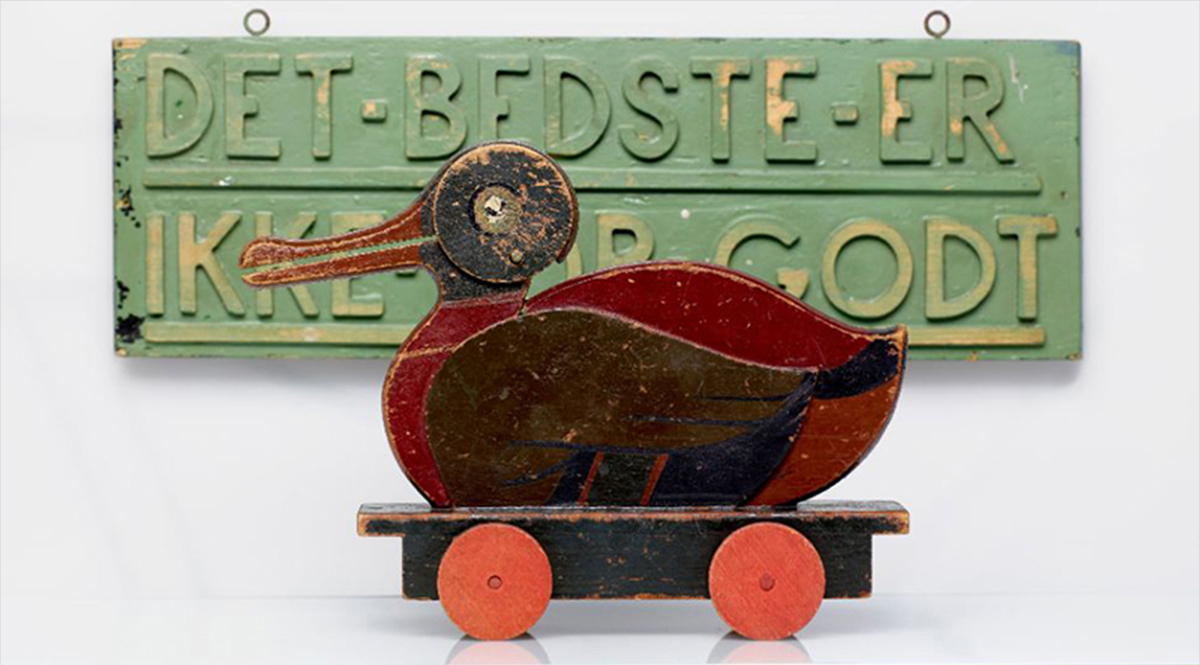
It was during this time of economic hardship that Kristiansen renamed his enterprise as LEGO—a portmanteau derived from the Danish phrase “leg godt,” meaning “play well.” His steadfast commitment to uncompromising quality and innovative design bore fruit as LEGO’s repertoire of wooden toys captured the imaginations of children far and wide. Their most iconic toy of the time was a wooden duck with its whimsical beak that open and closed as it was pulled along by a string.
Yet, the bad luck of Ole Kirk loomed once more with the ravages of fire in 1942, again leveling the workshops. Rising from the ashes of destruction, Christiansen embraced the burgeoning era of plastics, investing in cutting-edge plastic-injection molding technology. In the post war Denmark, this new technology was also being pushed by the government and by industry. Kristiansen began working with a single plastic injection machine in 1947. The company was still making wooden toys while experimenting with this new technology. By Denmark law, no one could produce any plastic products for profit in the post war economy. It wasn’t until 1949, that the company was allowed to sell products. At that time, one of the most famous pieces was a single piece plastic train. Not much later, and with much less fanfare, the Automatic Binding Brick was introduced to the market.
Now this brick has an interesting little story involving Mr. Harry Page of England. Harry page has invented an interlocking cube system in the 1940’s. It was constructed of wood and was hollow to allow other little elements to be placed inside these cubes. This toy was called Kiddicraft. Page eventually abandoned wood and moved to plastic for the interlocking building cubes. Harry had patents for this toy in England and a few other countries. Rumor has it that Harry met Ole Kirk at some point in the 1940’s as they were both exploring the new plastic mold injection technology. It is very unclear as to any agreements made between Harry and Ole Kirk about the use of the design. But the toys produced by Page never saw great success and by the late 1940’s early 1950’s he had moved on to plastic injection molding of miniatures. Unfortunately, due to the pressures of his business and other reasons, Harry Page committed suicide in 1957. This was and still is a bit of controversy about the creation of Lego. Lego has always stated that Page allowed Ole Kirk to use the design. The real truth will probably never be known at this point. While there was no true determination about the origins of the Lego brick, the Lego Company bought the rights to Kiddicraft and the company in 1981.
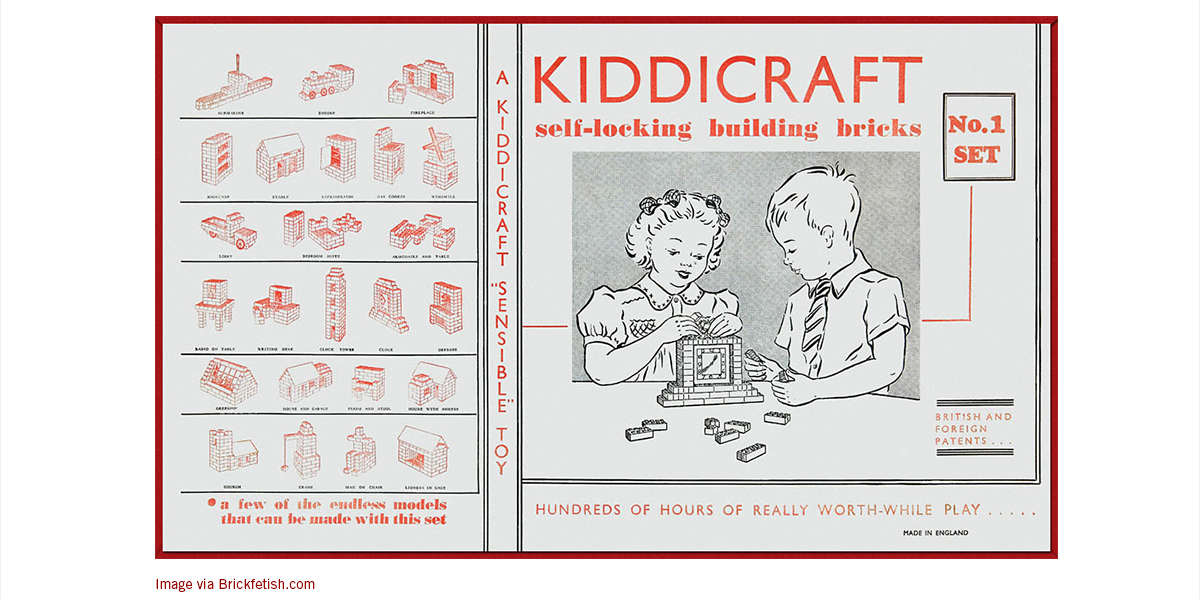
The early 1950’s saw a boom in the Lego brick as we know it today. In 1953, the Automatic Binding Brick is renamed the “Lego Brick”.. In 1953, the adoption of the patented coupling system comprised of hollow tubes on the underside of LEGO bricks, ensured seamless interlocking, and solidified the foundation of LEGO’s iconic building system. Then in 1953, under the guidance of Gottfried Kristiansen, Ole Kirk’s son, Lego introduces what they called “The System of Play.” This was the idea that Lego bricks could be complied into a multitude of shapes, elements, and things without limit. The more Lego you have, the more you could create. This concept revolutionized playtime, emphasizing the interrelatedness of all blocks and fostering imaginative exploration. This system has not changed even today if you can mix and match Lego from 1955 to the present. Pretty cool!
Shortly after this boom in Lego systems, yet another fire took out part of the factory in 1960. This time the fire sealed the fate of the company as it only destroyed the woodworking portions of the factory. So from that day forward, Lego focused solely on the plastic bricks. The following decades witnessed the growth and expansion of achievements for LEGO. The introduction of the LEGO train system in 1966 and the debut of the mini-figure in 1978 marked milestones in LEGO’s history. Then in 1968 , Legoland Park was established in Billund and further increased LEGO’s cultural footprint, captivating audiences with its immersive experiences.
Yet, LEGO’s journey was not without its trials. The harrowing brush with bankruptcy in 2003 served as a sobering reminder and prompted some strategic realignment under the stewardship of CEO Jorgen Vig Knudstorp. Embracing a back-to-basics ethos, Knudstorp streamlined LEGO’s operations and refocused the company on its core product offerings. While the company has a new CEO, the Kristiansen family still has members on the Board of Directors. (although now it is spelled with CH and not K).
As societal consciousness shifted towards environmental sustainability, LEGO received some push back for all of the plastic they use in their toys. So in response, Lego pledged to adopt more eco-friendly practices. Initiatives such as the transition to sustainable materials and the implementation of zero-waste packaging underscore LEGO’s commitment to responsible stewardship.
So today the Lego Company produces 20 billion pieces per year and continues to stretch into more areas of pop culture and main stream society. Yet they still are one of the most painful things to step on in the middle of the night! But I continue to enjoy the evolution of the company, the sets it creates, and the creativity they inspire in the world.

Would You Rather jump to
My neighbor recently gave me a book of 3,000 “Would You Rather” questions and I have spent some time going through all the options to see if there are any in here that are worth discussing. I selected today’s question about 10-minutes before we started recording and Andrew hear it about 2-minutes before we started recording. All of that is to say, we had to work through the ramifications to this question.
Would you rather be abducted by Aliens or bitten by a Vampire?
Yes … as we worked through this, Andrew’s logic went straight to the idea that alien abductions are all about getting probed whereas being a vampire means he gets to live forever and is super fast (but wanted to be turned about 10 years ago). For me, alien abductions had more to do with being snatched up and leaving the planet never to return. You might see something amazing and experience all the pro’s of a vastly more developed race (although how advanced could they be if they are flying around the universe stealing people??) There is a lot more to this question that you might originally think – working through the possibilities is why these questions are entertaining.
EP 144: Objects of Design
So that wraps up the first of two episodes we will tackle this year on “Objects of Design”. Andrew and I have both talked about how much fun these episodes are, mostly because we both learn something that we didn’t know, about some object that we already love. I started this process looking for a good story only to then select it as my choice but it appears that with enough digging around and some research, you discover that most interesting objects have an amazing backstory to them already. You also realize that is would also suggest that greatness doesn’t normally just happen – there are always extenuating circumstances that add a bit of color to the process.
Until next time,

Be sure to check out our friends Construction Specialties – they are so focused on the importance of helping architects achieve their creative vision, that they have created a CEU academy with multiple courses concerning all aspects of design. These courses are each worth 1 AIA LU or 1 IDCEC CEU/HSW. Visit masteringmovement.net to take this and other courses.

